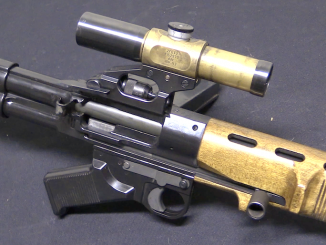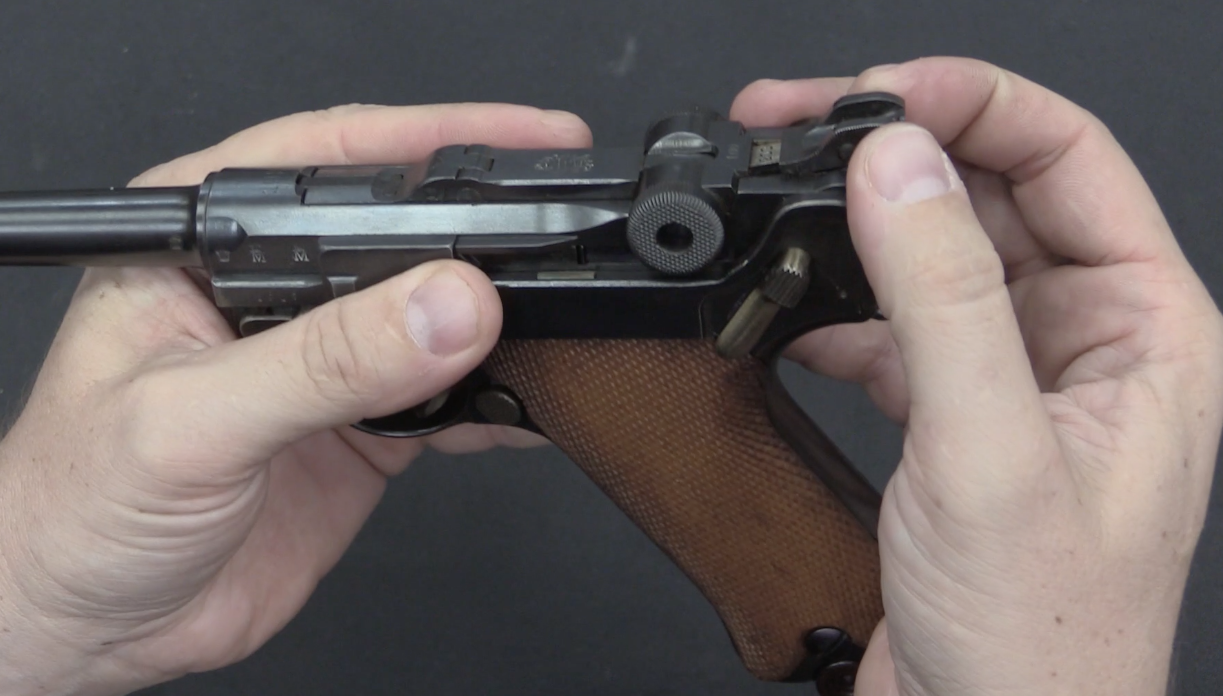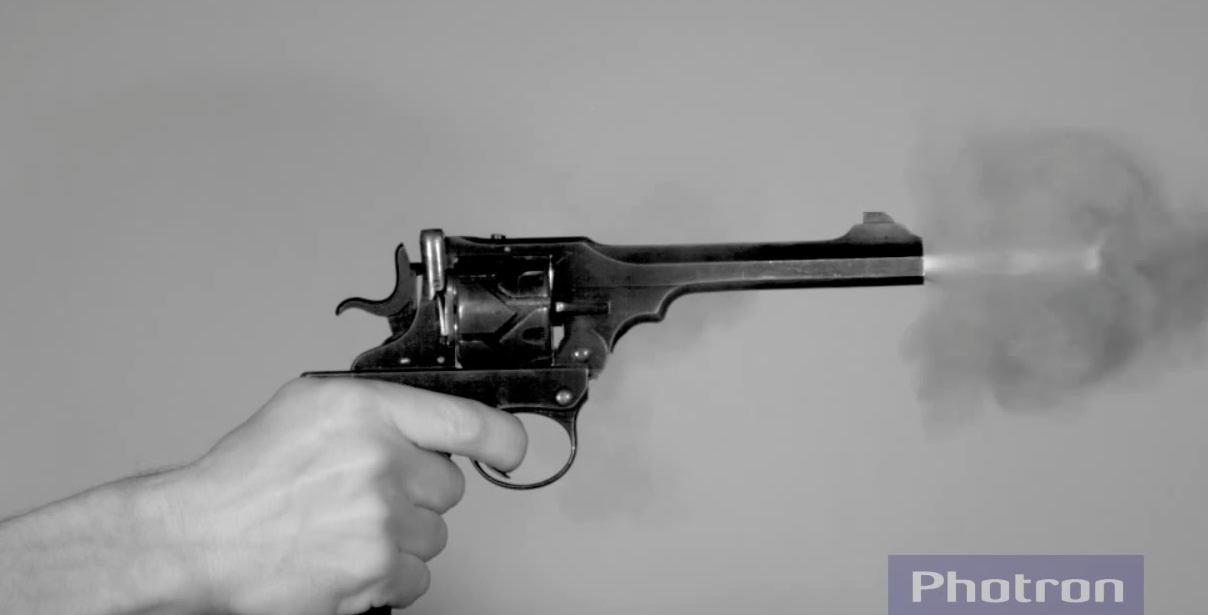The Tirmax is a handy little carbine made between 1909 and 1914 in Liege by a German company. It is a semiauto action using a 5-round detachable magazine. The guns are quite scarce today because only a fairly small number appear to have been produced before World War One ended its manufacture.
Mechanically, the Tirmax is simple blowback, although incorporating a heavy hammer spring into the system to increase the bolt’s resistance to opening when fired. The hammer also has a lever extension on the left side of the receiver, allowing it to be manually cocked prior to manually cycling the bolt.
Out on the range, this particular example exhibited a bunch of problems, although that may or may not be representative of overall production. In addition to feed problems, I had one instance where the firing pin appears to have stuck in the forward position, resulting in 3 rounds slam firing in extremely fast succession – note that this is part of why one does not put one’s hand over the ejection port! After that incident, I stopped firing and the gun’s owner will have it looked at by a good gunsmith.




The Tirmax depends on an patent from Julien Warnant in Belgium. One of the points in this patent that the system is an delayed blowback, Warnant used for this an “Hemmstück” or “blockingpart” between bolt and spring. The rifle and system was patented 1909 in the USA, the rifles was made in Liege and were sold by Franken&Lünenschloss, Cologne and Liege untill 1915. By reaserching the sn’s it looks like about 300 where made. I have wrote an article about the history of the tirmax in the german gun mag “Visier”, issue 06-2013
It looks to me like the bolt doesn’t cock the hammer directly, but uses an intermediate piece to cock the hammer. As the bolt moves rearward, the intermediate piece pushes on the hammer. The rounded lump on the hammer redirects some of the force towards the hammer pivot and not towards cocking it. As the angles change more of the force is directed to cocking the hammer. Toward the bottom http://www.littlegun.be/arme%20belge/artisans%20identifies%20t%20w/a%20warnant%20creon%20julien%20gb.htm
Looks much nicer than our current production .380 ACP carbine, the HiPoint.
Creon Julien Warnant, US patent Nr. 0908631. A locking block under the bolt props against hammer under spring tension. Somewhat similar 1910 Glisenti pistol with differences that rather narrow locking surface and support from hammer rather than barrel extention.
Forgotten the most important point; No barrel movement…
After introduction of Browning No. 1 https://modernfirearms.net/en/handguns/handguns-en/belgium-semi-automatic-pistols/fn-browning-m1900-eng/ by FN Herstal in Europe, 7,65 mm Browning [.32 Auto] cartridge became immensely popular, mostly in automatic pistol, but also in carbines – Tirmax and Dreyse, see photos: http://www.littlegun.info/arme%20allemande/a%20dreyse%20gb.htm and even revolvers stylized (if that is correct word) to looks like automatic pistol, see photos: https://www.kalashnikov.ru/pistolver-iz-belgii/
even with compartment in grip for cartridges (see first image in chapter Патроны, left part shows FN 1900 magazine and right part – detail of revolver automaticpistolllookalike)
Barrel looks some 45 centimeters, .32ACP bullet weights some 4,5 grams and casehead square divided bullet back square value;1,5… From these findings the free insured blowback as accepted 2 milimeters needs approximately 150 grams of recoiling elements including; Bolt, hammer and their springs weights.. lt would be needed no delaying aid for a this size gun. lMHO.
Bolt weight is 95 gramm. Dont forget that in the time of the construction self loading was a kind of mystery. The goal was to get absolutely shure that the bolt dont open before the bullett left the barrel.
If the bolt opened before the bullet was past the muzzle, you’d get a face full of gas and plenty more unpleasant surprises.
The free blowback distance at extent of lenght of a .32 ACP case is 25 milimeters and in a blowback firearm it needs only some 12 grams of closing weight including all recoiling elements which should be impossible to find in the existing firearms. Besides, most of handgun size firearms using popular calibers are not subject to supposed issues such as case head seperation and other dangerous happenings at blowback action even with underweighted bolts. Even plugged bores might not realise such an issue. This is a reality but of course should be avoided in all cases.
Thanks for the bolt information and era when the gun was made. Of course you are right… But experiment should be base of the improvements and Dreyse seemed to achieve this. Furthermore; Adding the hammer and returning springs weight, the insured free blowback distance might be provided.. Besides, even the bolt weight of 95 grams would provide some 3,2 centimeters free blowback still remaining in the insured distance through casehead thickness. However, the case factor of manufacturing costs should not be as important at that era compared as nowadays. Thanks again for your interest.
Lovely little carbine. It may be problem with FP protrusion or maybe just needs to disassemble, clean and lube (old grease?). The action does not seem to have free run either.
How instantaneous is NiTi’s change: “The second key point is that the transformation in both directions is instantaneous” from:
https://en.m.wikipedia.org/wiki/Nickel_titanium
I’ve read that link a few hundred times, honest. And other things, but… I am stuck on the issue, so! For example could a Nitinol bolt hypothetically “just imagine this guns bolt but made from NiTi” for simplicity, expand with heat (as designed in this instance) inside the reciever and thus slow the bolt down.
Anyone know? I can shut about it then.
Up… About (correction)
Worth to think…
Worth a think?
Who wants to hear about my new Americium-241 idea for shrinking powder charges? 🙂
Meh Philistines.
Oh hey, doggo!
Oh hey again, happy doggo!
SORRY…
Made a “,” mistake in computing due bolt weight for this gun… lt needs “x10” for all values…
This means the delay mechanism works more than supposed… lt seems Monsieur Warnant had made all necessary computing and experiments…
Sorry again…
I have one of these guns. They seem to be quite rare in the US.
Its quite fun to shoot (I think this example needs cleaned and lubed) and is very quiet (for a gun). I like it better than the Dreyse carbine.
Steampunk precursor to the Hi-Point carbine imfdb.org
Boy, does that remind me of a little brother to the Remington Model 8. Too young to recoil his barrel………………